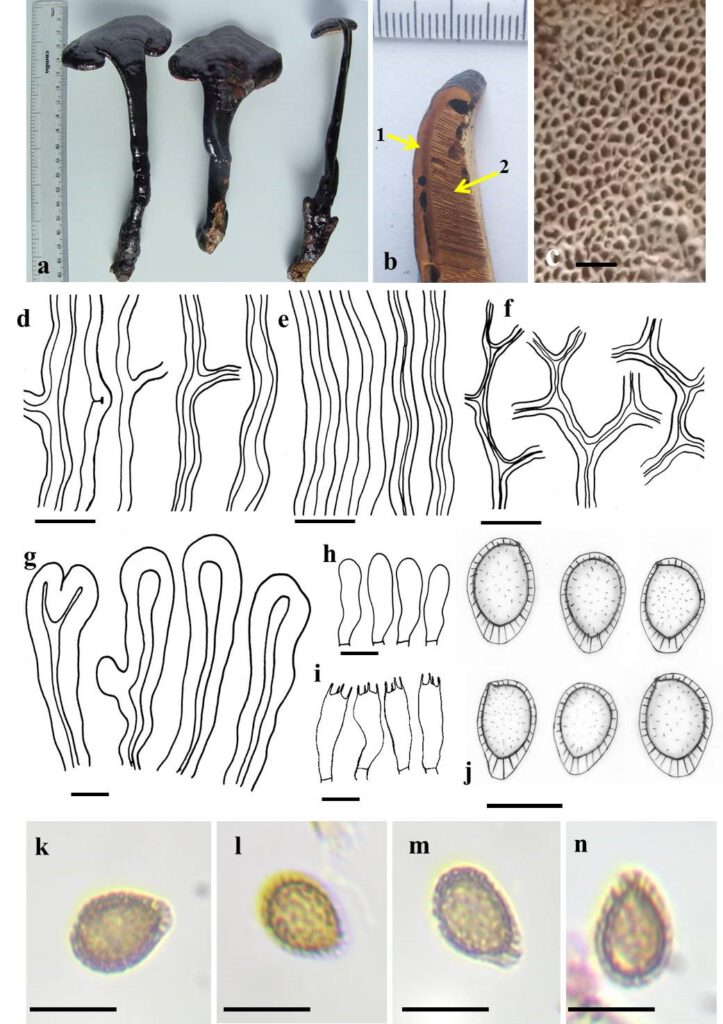Ganoderma tamilnaduensis Kaliyaperumal, M., & Kezo, K., sp. nov.,
MycoBank number: MB 558477; Index Fungorum number: IF 558477; Facesoffungi number: FoF 10727; Fig. 3
Etymology: “tamilnaduensis” refers to the place of collection.
Holotype: MUBL4015
Description: Basidiocarps annual, solitary, pileate, sessile, applanate, leathery when fresh and woody to corky when dry. Pileus semicircular, convex, projecting up to 5 cm, 10 cm wide and 2 cm thick. Pilear surface greyish brown (10F3), covered by a laccate layer, mild zonation in older specimen. Stipe lateral, cylindrical in younger specimen, flattening with age and towards the pileus, brown (10F3), up to 17 cm height and 2 cm thick. Margin acute, white (10A1). Pore surface yellowish white (4A2). Pores round regular, 3 – 4 per mm. Context up to 1.5 cm, homogeneous, brown (6E7) to dark brown (6F7). Tubes brown (6E7) to light brown (6D8), up to 3 mm thick.
Hyphal system trimitic, Skeletal hyphae dominant. Context Generative hyphae, thin to thick walled, hyaline, clamped septate, branched, 2.5 – 6 μm diam.; skeletal hyphae, thick-walled with narrow lumen, unbranched, rust brown, aseptate, 3.7 – 7 μm diam.; binding hyphae, thick-walled with narrow lumen, branched, aseptate, 2 – 3 μm diam. Trama Generative hyphae, thin to thick walled, hyaline, clamped septate, branched, 2.5 – 4 μm diam.; skeletal hyphae, thick walled with narrow lumen, rust brown, aseptate, unbranched, 3.5 – 7 μm diam.; binding hyphae, thick-walled with narrow lumen, branched, aseptate, 2.5 – 3.5 μm diam. Cutis cell clavate, 20 – 70 × 10 – 15 μm, Cystidioles absent. Basidioles clavate, 17.5 – 22 × 6 – 8 μm. Basidia clavate, with four sterigmata, 20 – 27 × 6 – 10 μm. Basidiospores ellipsoid, brown, thick-walled, truncate at the apex, exospore thin, subhyaline, smooth, endospore thick, brown, echinulate; (11.2-) 11.5 – 12.2 (-13.2) × (7.5-) 7.7 – 10 (-10.2) μm (n = 30/2), Q = 1.2 – 1.4; CB ̄, IKI ̄.
Specimen examined: INDIA, Tamil Nadu, Coonoor district, 11°21’29.2“N 76°47’48.7“E on dead wood, 24th December, 2002, Malarvizhi Kaliyaperumal (Holotype, MUBL4015).
GenBank numbers: ITS: DQ011635/ DQ011636 β-tubulin: DQ011572
Notes: Ganoderma tamilnaduensis shares similarity with G. lucidum complex by having semicircular and convex pileus and presence of stipe however, G. tamilnaduensis differs by having long cylindrical to flattened stipe, measuring up to 17 cm height and 2 cm thick. Microscopically, our Indian species has larger spore size as compared to the species in G. lucidum complex, (11.2-) 11.5 – 12.2 (-13.2) × (7.5-) 7.7 – 10 (-10.2) μm (Zhou et al., 2015). Our Indian species has larger basidiomata and basidiospores that differ from temperate regions of Northern hemisphere specimens namely G. carnosum, G. luecocontextum, G. tsugae, G. luteomarginatum and G. neojaponicum in having Basidiomata (including larger pileus and stipe) and larger basidiospores (Hapuarachchi et al. 2019). G. tamilnaduensis stands and isolated in Cluster A1 of Clade A as mentioned elsewhere (Fryssouli et al., 2020).

Fig. 2: Ganoderma tamilnaduensis (MUBL4013, halotype). a Basidiocarp. b1 Context. b2 tube layer. c Pore surface. d Generative hyphae. e Skeletal hyphae. f Binding hyphae. g Cutis cell. h Basidioles i Basidia. j Basidiospores. k Basidiospore in H2O. l Basidiospore Melzer’s reagent. m Basidiospore in cotton blue. n Basidiospore in phloxine. Scale: c = 1 mm d – n = 10 µm.
